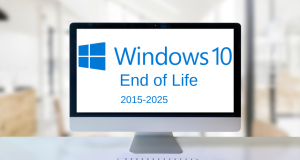 Impact on Business Operations and Planning
Impact on Business Operations and Planning
Our objective is to provide our partners with ample time to plan for capital expenditures and upcoming operating system upgrades, particularly when reliant on hardware replacements.
With the end of Windows 10 support less than 7 months away, combined with the impact of tariffs likely to increase hardware costs, it is prudent to reconsider any strategy that involves delaying Windows 11 upgrades.
Windows End of Life
As you may be aware, Microsoft periodically ends support for older versions of its Windows operating systems. The end of life (EOL) for a Windows product signifies the end of all support, including security updates, patches, and technical assistance. This poses significant risks, such as vulnerability to cyber threats and incompatibility with newer software applications.
Key Dates to Note:
- Windows 10: Support ends on October 14, 2025.
- Windows 7: Support ended on January 14, 2020, with extended support available until January 2023. This article assumes that all Windows 7 devices have been upgraded and are no longer operating in your environment. If, for some reason there are any Windows 7 devices in your environment, those should be prioritized and immediately addressed.
The cessation of support necessitates a timely transition plan to newer, supported versions of Windows, such as Windows 11. This transition will require careful resource allocation, including budgeting for software licenses, compatible hardware, and the necessary training for staff.
What are the potential impacts if you don’t meet the deadline?
- Increased Vulnerability: Without regular security patches, your systems could be exposed to newly discovered threats—potentially putting sensitive data and operations at risk.
- Compatibility Issues: As technology evolves, software vendors will begin to optimize and develop their applications for newer operating systems. Over time, you could face performance issues or reduced functionality if you remain on an outdated OS.
- Compliance Risks: Certain industries have strict regulatory standards around data protection. Running end-of-life software can lead to non-compliance and financial penalties.
Anticipated Tariffs on Hardware Purchases
In addition to the software challenges, the imposition of tariffs on imports is creating a degree of unpredictability, particularly regarding the costs of hardware components such as computers, servers, networking equipment, and other essential peripherals. These additional costs can impose strain on budgets and delay planned upgrades or expansion initiatives. Higher tariffs directly impact the financial outcomes for manufacturers, resellers, and ultimately, end customers.
What do you need to be prepared for?
Higher Prices: When tariffs increase, so do costs. The longer you wait, the higher the probability of paying a premium for the same hardware you can get today at a lower price.
Supply Chain Disruption: Tariffs can strain global supply chains, causing possible shortages or longer lead times. If you plan on installing or upgrading new systems for your team, it’s wise to lock in your purchase before these potential disruptions take hold.
Budgeting Challenges: Sudden hardware price hikes could force you to stretch—or completely revise—your IT budget. By acting now, you protect yourself from unexpected cost overruns later.
How can you get prepared?
- Review current inventory and assess the urgency of hardware replacements.
- Explore alternative suppliers or locally sourced components to mitigate tariff impacts.
- Consider purchasing bulk and in advance to avoid potential tariff implementation
What action steps could you take?
- Engage a partner like Progressive Computing, who can help you all or any of the below steps.
- Conduct a comprehensive audit: Evaluate current systems to identify which devices and software versions are in this EOL category.
- Develop a phased upgrade strategy: Prioritize upgrades based on criticality and compatibility. Schedule upgrades in phases to manage workloads and minimize disruptions.
- Budget forecasting: Ideally you have already budgeted for the costs of new software licenses and hardware for this year’s fiscal budget. If you didn’t, let’s look at what your options are, and aim to address, and ideally mitigate potential tariff impacts within the cost estimates.
- Supplier engagement: Engage with current and potential suppliers to explore options for mitigating tariff costs. Negotiate favorable terms and explore alternative sourcing strategies. Progressive Computing has already done some of this work on your behalf, and can negotiate the best pricing with our trusted vendors.
- Staff training and support: Plan for training sessions to ensure smooth transitions to new systems. Provide support resources to address any issues that arise during the upgrade process.
Why is this Important?
The dual challenges of Windows end of life and rising hardware costs require proactive and strategic planning. By addressing these issues head-on, we can ensure the continued security, efficiency, and competitiveness of our operations, while adhering to your budget requirements. Our goal is to ensure you experience optimal performance, security and reliability from your devices. Our partnership is this engagement will be crucial for mutual success.


